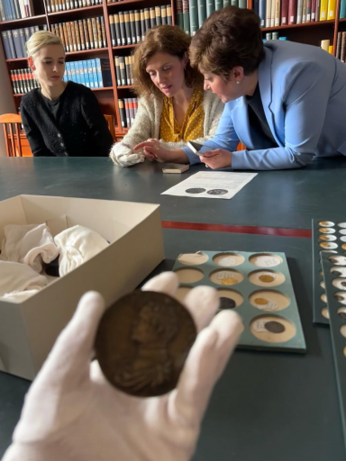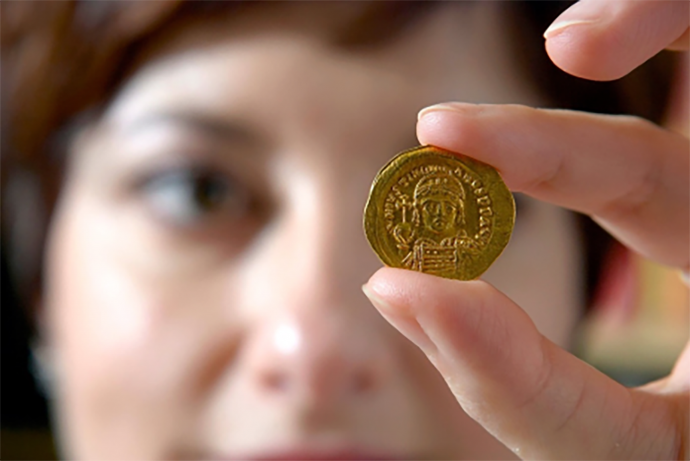On March 20, 2024 we were privileged to visit the Münzkabinett (Numismatic Collection) at the Bode Museum in Berlin, a visit that left us with a deeper appreciation for ancient and medieval coins and their role in the dissemination of astral imagery. Dr. Karsten Dahmen, the deputy director of the Münzkabinett, warmly welcomed our MPIWG group and generously guided us through the museum’s fascinating spaces.
The tour included the library, study rooms, and digitization lab, as well as the impressive Münzkabinett Depot, where thousands of coins are meticulously stored with space to store even more in the case of an emergency. This behind-the-scenes glimpse into the coin preservation process underscored the immense care and attention to detail required for this invaluable numismatic collection. Holding a Roman medal, we couldn’t help but marvel at its weight and imagine Romans of the past carrying these hefty items—perhaps in small bags, as pockets had yet to come into fashion.
Eurydice Georganteli, a distinguished numismatist from Harvard University and a Senior Research Fellow in the “Visualization and Material Cultures of the Heavens in Eurasia and North Africa” (VoH) working group at MPIWG, led this field trip and shared her expertise with us. Among the thousands of coins, Eurydice had thoughtfully selected examples that depicted the heavens in various forms: celestial globes, comets, stars, the sun, the moon and more.

Photo by Alvin X. Yang
This rare, hands-on opportunity allowed us to explore the interplay between celestial symbols and the material world. Using magnifying glasses to study the fine details of these coins, we were struck by how astral imagery seemed to serve a deliberate purpose. These objects not only served as tools of exchange, but also as symbolic instruments, encapsulating complex ideas about the heavens, authority, and the cosmos— ideas that traveled across both time and space, enduring long after the initial minting of the coin.
In the VoH working group, we have been exploring the connection between coins and astral knowledge, and this field trip brought that research to life. It allowed us to engage with numismatic artifacts as primary sources and stimulated rich discussion among our group, with experts providing invaluable insight into the creation, distribution and cultural impact of these coins. This field trip also deepened our appreciation for the immense labor involved in preserving and documenting these artifacts. From the meticulous process of cataloging to the cutting-edge digitization efforts that make the collection accessible worldwide, it is clear that the Münzkabinett is not just a repository, but a dynamic space for scholarly engagement. The superb digital catalog, which offers unparalleled access to the numismatic collection, represents a valuable resource for scholars and enthusiasts alike, ensuring that these ancient treasures continue to inform our understanding of the past.
We left the museum inspired and eager to return in the future, particularly for the upcoming exhibition,
Sticky Fingers – Counterfeit Coins The Dark Side of Numismatics,
when we will have the chance to test our skill at distinguishing between originals and counterfeits displayed side by side!

Byzantine gold solidus of Emperor Justinian I (527-565) from the Barber Institute Coin Collection

Dr. Karsten Dahmer, the deputy director of the Münzkabinett
